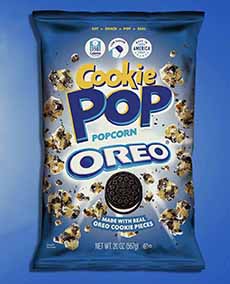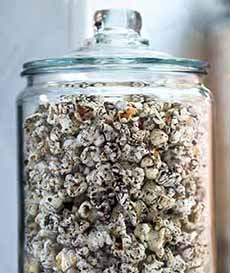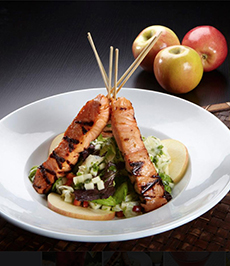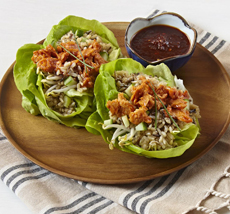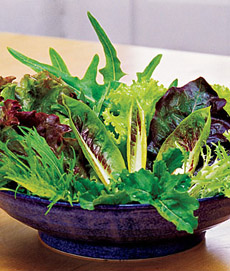|
Green garlic—also called young garlic or spring garlic—may look like scallions. But they are the immature, spring version of the cured bulbs available year-round.
Harvested when young, green garlic looks like scallions (a.k.a. green onions). The bulb has not yet begun to separate into cloves (photo #1).
At this stage in its youth, the whole plant is edible. It has a sweeter, milder flavor than fully cured garlic bulbs/heads (photo #4).
If left in the ground to to grow, the bright green tops die off after the bulbs underground have rounded out into the bulb/head.
When the mature heads are dug up and hung up to dry, the papery cellulose layers around and between the cloves of the bulb form a protective layer that enables the heads to stay in storage for up to a year.
DIGGING IN TO GREEN GARLIC
When garlic is young and green, the whole plant is edible, like a scallion. It has a sweeter, milder flavor than when the garlic bulbs are fully cured.
Green garlic often looks so similar to green onions and spring onions, that the best way to identify green garlic is simply to take a sniff. It will smell of garlic rather than onion.
Another giveaway: Green garlic leaves are flat (photo #1); scallion leaves are tubular.
USES FOR GREEN GARLIC
Use green garlic raw or cooked, wherever you’d like subtle garlic flavor. Prepare it as you would a scallion, and use it in:
Braises, sautés* and grilled vegetables (they’re great charred, as a side)
Egg dishes: breakfast eggs, deviled eggs, frittatas, quiche
Dips and spreads, like hummus or yogurt dip (mix yogurt with green garlic pesto)
Grains and grain bowls
Herb butter (compound butter for potatoes, spreads, veggies)
Pesto
Pickled garlic (how to pickle)
Pasta and pizza
Salads and salad dressings
Sauces
Soups and soup garnish
Savory yogurt or yogurt sauce/dressing
Try green garlic in a stir-fry, chopped up with eggs, or sautéed with greens. For a quick (and delicious) kitchen project, use green garlic instead of basil in your next batch of pesto.
Use it wherever you’d use regular bulb garlic or green onions, or use it in recipes specifically designed to grilled, or pickled. Add it to a frittata, a soup, or pair it with other spring treats like asparagus. Put green garlic in pasta, a rice bowl (don’t forget to pick up pea shoots),
Our personal favorite is a saute of asparagus, green garlic, morels, ramps and spring peas. Made with butter or olive oil, we can eat an entire batch of it on noodles or grains.
WHAT ARE GARLIC SCAPES?
Scapes are the curling shoots of young garlic plants (photo #3). They will grow into green garlic.
For decades they were cut off in the fields and thrown away, to allow the garlic bulbs to grow larger, before growers realized that chefs and foodies were eager to buy them.
The curling shoots have more intensity than green garlic, and it’s best to blanch them first. This unleashes a milder, sweeter flavor.
Just dip the scapes into salted boiling water for 30 seconds, then place them in an ice bath. You’re ready to roll.
Use garlic scapes the same ways you would green garlic.
How about some Potato, Nettle & Green Garlic Soup?
FOOD 101: SCALLIONS, GREEN ONIONS & SPRING ONIONS
While many people use the term “green onions” for scallions, we prefer scallions. Why?
There are also spring onions, different from green onions.
Spring onions look similar to scallions a.k.a. green onions. It’s easy to confuse them.
Sometimes the easy way to tell them apart is from the bulbs: If the ends are very bulbous, it’s a spring onion. But some varieties have smaller bulbs.
|
|

[1] Green garlic: not scallions, a.k.a. green onions (photos #1, #2 and #5 © Good Eggs).

[2] Some varieties of green garlic have purple at the base.

[3] The first form of garlic to emerge is garlic scapes. They will grow into green garlic, and finally garlic bulbs/heads (photo © Vicia Restaurant | St. Louis).

[4] Scapes and green garlic will eventually turn into garlic bulbs/heads (photo via Domain Image [site now closed]).

[5] Green garlic and nettle soup. Here’s the recipe from Good Eggs.
|
